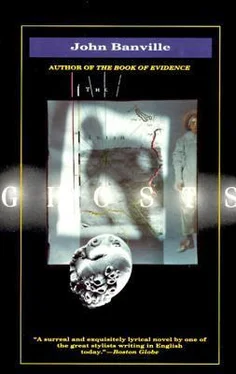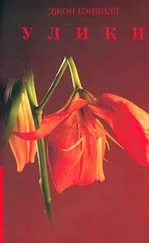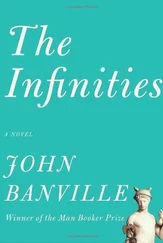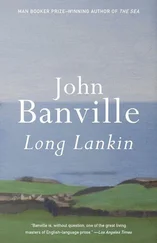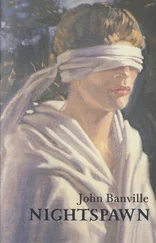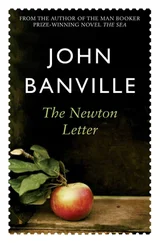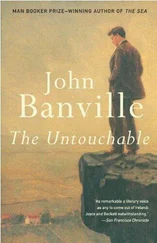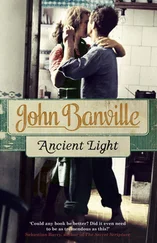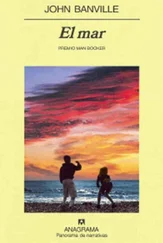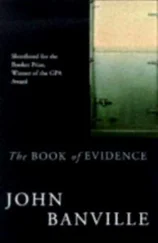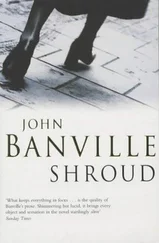HE STANDS BEFORE US like our own reflection distorted in a mirror, known yet strange. What is he doing here, on this raised ground, in this gilded, inexplicable light? He is isolated from the rest of the figures ranged behind him, suspended between their world and ours, a man alone. Has he dropped from the sky or risen from the underworld? We have the sense of a mournful apotheosis. His arms hang loosely forward from his sides, his splayed feet are arranged in a parody of the mannered stance of prince or soldier posing for an heroic portrait. He seems trapped, held fast by invisible constraints. He might be in the stocks, or worse. We notice the pipe-clayed slippers tied with crimson ribbons in enormous, floppy bows, the broad satin trousers that are too short for him, the outsize coat of white twill, with its sixteen buttons, the rucked sleeves of which seem ample enough to accommodate the arms of an ape. Who has dressed him up in this clown’s attire? For he has the look of having been bundled into his costume and thrust unceremoniously out of the wings to stand up here all alone, dumbfounded, mortified, afraid to move lest an unseen audience break into a storm of laughter; yet although for now he is lost for words, we have the feeling that at any moment he may burst out and talk and talk, unstoppably. He wears a limp ruff of white lace, a skullcap, or perhaps it is a headband, and a hat with a wide, circular brim pushed far back on his head. The head is oval, with a broad brow and receding chin. His gaze is at once remote and penetrating, his eyes are a greenish brown. His hair, what we can see of it, is black, or perhaps red. He seems weary. The eyelids, lips and nostrils are tinged with pink and appear to be inflamed; has he been weeping? Yet the corners of his fleshy mouth are dimpled in a sort of smile, distant, pained perhaps, without warmth. We have the impression of past suffering and a present numbness. Perhaps behind that pensive gaze he is laughing at us.
The X-rays show beneath his face another face which may be that of a woman. Pentimenti will out. (See fig. I. Behrens Collection, recent acquisition.)
The figure of Pierrot derives from the Italian stock characters Pedrolino and the Neapolitan Pulcinella. These characters were introduced to the Paris Fairs by the King’s Company of Italian Comedians towards the close of the seventeenth century and were transformed into the more familiar French form not long before Vaublin’s arrival in Paris from his native Holland in the early 1700s; he would have seen the part played at the Comédie-Française by the great Biancolelli among others. Pierrot, disguised in outfit and in personality, is the childish man, the mannish child. Traditionally, as here, he wears a headband or skullcap and pleated ruff, broad silk trousers, a buttoned coat of silk or white twill with loose sleeves and white or black pumps. He appears in whiteface, though not always. Not always. In certain manifestations he is endowed with a humped back and a protruding chest, reminding us of his roots also in the character of Punch, that malign figure which itself dates from the time of the Roman circuses. He does not usually carry a club; in this instance, he does.
*
It is a large work, more than two metres high. Pierrot is slightly greater than lifesize. This disproportion, and the elevated placing — he seems somehow to hover in mid-air — lend a sense of lowering massiveness to an otherwise unremarkable, even absurd figure. Note too that Pierrot, for all his centrality in the design, is not centrally placed in the composition, but set a little way to the left; the small displacement creates an unsettling subliminal effect, which it is hard to believe is not intentional. Yes: a subtle harmonics is at work here, which plays upon our expectations of symmetry and balance; in the overall arrangement is there perhaps a sly parody of the rules of golden section? It is difficult to say which effects are intentional and which accidental.
The design of the work, the strange yet strangely pleasing asymmetry in the placing of the figures within the enveloping frame of trees and clouds and hazy, far-off sea, which strikes the viewer as at once arbitrary and inevitable, generates an air of mystery over and above the question of what it is that is happening and who or what the figures may be meant to represent — beyond, that is, their commedia dell’arte roles. Similar treatments of such subjects, by the same artist and others (Pater, Lancret, Watteau in particular), are equally baffling as to plot , if the term may be so employed, yet these works have not become the objects of unremitting, often ingenious yet for the most part futile speculation, as is the case with this work. Evidently there is an allegory here, and symbols seem to abound, yet the scene carries a weight of unaccountable significance that is disproportionate to any possible programme or hidden discourse. It is first of all a masterpiece of pure composition, of the architectonic arrangement of light and shade, of earth and sky, of presence and absence, and yet we cannot prevent ourselves asking what it is that gives the scene its air of mystery and profound and at the same time playful significance. Who are these people? we ask, for it seems to matter not what they may be doing, but what they are. Above all, who is this Pierrot? He is presented to us upright in darkening air, like a figure from the tarot pack, lost inside his too-large costume, mute and solitary, sorrowful, laughable perhaps, and yet unavoidable, hardly present at all and at the same time profoundly, palpably there , possessed it seems of a secret knowledge, our victim and our ineluctable judge.
Who is he? — we shall not know. What we seek are those evidences of origin, will and action that make up what we think of as identity. We shall not find them. This Pierrot, our Pierrot, comes from nowhere, from a place where no one else lives; nor is he on his way to anywhere. His sole purpose, it would appear, is to be painted; he is wholly pose; we feel ourselves to be the spectators at a melancholy comedy. See how strangely he fits into his costume; he seems not so much to be wearing it as standing behind it, like a cut-out paper doll. Notice the small size of the head in relation to the trunk, the unnatural length of the arms, the very broad hips, the oversized feet. He is almost deformed — almost, when we look long enough, a freak. He seems someone to whom something terrible has happened, or who has done some terrible thing, the effects of which upon his personality are suggested by these marked and at the same time subtle physical exaggerations. What is it he has done, what crime is he guilty of? And from whom is he hiding, if he is hiding? That smirking Harlequin mounted on the donkey seems to know the answers. Is it he who has lent Pierrot his club?
How deeply do we look into these depths? There is no end to what we may see. Consider this sky. Supposedly it is blue; we say, Pierrot stands outlined against a blue sky . In fact, what blue there is is more a faded, bluish green, and the effect is further softened by a scumbling of ochreous pinks. lower down, the shades range from turquoise through a watered mauve to deep indigo towards the barely discernible horizon of the sea; as is frequently the case in this master’s work, evening is coming on, seeping up like a violet mist out of the earth. The cloud-mass on the right, behind the trees, is particulary well executed, a tarnished, whitish gold bundle, corpulent and dense. We might think that this is one of those high, smoky gold skies of early October, were it not for the tender foliage of the trees and the general sense of movement and expectancy. It is spring, surely, a cool, restless evening late in spring. We note the crepuscular, fulvous light, the softly thickening shadows; we feel the wind in the trees, in the clouds, and sense the stirring of the earth, the green shoots rising and the tight buds preparing to unfold. This is the springtime not of fêtes and fairs and gambolling milkmaids, but a more savage season, quick with a sense of the struggle in pain and darkness of things being born.
Читать дальше
